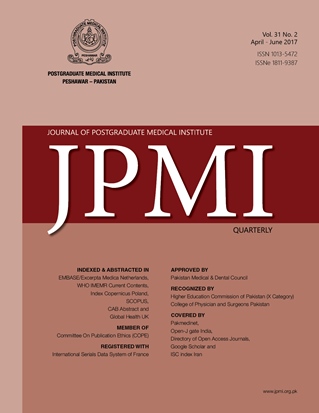BIOEQUIVALENCE EVALUATION OF TWO CLARITHROMYCIN TABLET FORMULATIONS: A RANDOMIZED, SINGLE-DOSE, OPEN-LABEL, TWO-TREATMENT PERIOD CROSS OVER STUDY IN HEALTHY MALE PAKISTANI VOLUNTEERS
Main Article Content
Abstract
Objective: To conduct the bioequivalence study of commercially available two
brands of clarithromycin tablets (500 mg) in healthy Pakistani male volunteers.
Methodology: The study was performed using a randomized, open labeled,
two treatment periods and cross over study design. Healthy volunteers (n =12)
were recruited following strict inclusion criteria. Their blood samples were collected
at various time intervals over a period of 24 hrs after oral administration
of test and reference formulations of clarithromycin tablets (500 mg). A validated
reversed-phase high performance liquid chromatographic method with
ultraviolet detection (RP-HPLC-UV) was used for the quantification of plasma
concentrations of clarithromycin. Various pharmacokinetic parameters were determined
using non-compartmental analysis approach.
Results: The Cmax, tmax, AUC0−t and half-life (t1/2) values of clarithromycin from
test formulation were 2.882 ±0.13 μg/mL, 1.75 ±0.45 hr, 11.33 ±0.68 μg.hr/mL
and 2.84 ±0.17 hr, while for reference formulation these were 3.089 ±0.19 μg/
mL, 1.83 ±0.39 hr, 12.87 ±1.09 μg.hr/mL and 3.10 ±0.28 hr, respectively. The
90% confidence interval values of Cmax, tmax, AUC0-t and half life for test and reference
formulations of clarithromycin were 0.89-0.98, 0.80-1.14, 0.84-0.93 and
0.88-0.95, respectively, which satisfied the acceptance ranges of WHO and FDA
bioequivalence guidelines i.e., 0.80-1.25. Similarly, in-vitro evaluation studies
were also performed for both test and reference formulations of clarithromycin
as specified in the official monographs in USP-30. Both formulations qualified
all the in-vitro tests as per specifications in their respective monographs. The
f1 and f2 values were also within the acceptance ranges for test and reference
formulations.
Conclusion: The test and reference formulations of clarithromycin were bioequivalent.
brands of clarithromycin tablets (500 mg) in healthy Pakistani male volunteers.
Methodology: The study was performed using a randomized, open labeled,
two treatment periods and cross over study design. Healthy volunteers (n =12)
were recruited following strict inclusion criteria. Their blood samples were collected
at various time intervals over a period of 24 hrs after oral administration
of test and reference formulations of clarithromycin tablets (500 mg). A validated
reversed-phase high performance liquid chromatographic method with
ultraviolet detection (RP-HPLC-UV) was used for the quantification of plasma
concentrations of clarithromycin. Various pharmacokinetic parameters were determined
using non-compartmental analysis approach.
Results: The Cmax, tmax, AUC0−t and half-life (t1/2) values of clarithromycin from
test formulation were 2.882 ±0.13 μg/mL, 1.75 ±0.45 hr, 11.33 ±0.68 μg.hr/mL
and 2.84 ±0.17 hr, while for reference formulation these were 3.089 ±0.19 μg/
mL, 1.83 ±0.39 hr, 12.87 ±1.09 μg.hr/mL and 3.10 ±0.28 hr, respectively. The
90% confidence interval values of Cmax, tmax, AUC0-t and half life for test and reference
formulations of clarithromycin were 0.89-0.98, 0.80-1.14, 0.84-0.93 and
0.88-0.95, respectively, which satisfied the acceptance ranges of WHO and FDA
bioequivalence guidelines i.e., 0.80-1.25. Similarly, in-vitro evaluation studies
were also performed for both test and reference formulations of clarithromycin
as specified in the official monographs in USP-30. Both formulations qualified
all the in-vitro tests as per specifications in their respective monographs. The
f1 and f2 values were also within the acceptance ranges for test and reference
formulations.
Conclusion: The test and reference formulations of clarithromycin were bioequivalent.
Article Details
How to Cite
1.
Samiullah ., Iqbal Z, Shah Y, Khan MI, Khan A, Nazar Z, et al. BIOEQUIVALENCE EVALUATION OF TWO CLARITHROMYCIN TABLET FORMULATIONS: A RANDOMIZED, SINGLE-DOSE, OPEN-LABEL, TWO-TREATMENT PERIOD CROSS OVER STUDY IN HEALTHY MALE PAKISTANI VOLUNTEERS. J Postgrad Med Inst [Internet]. 2017 May 12 [cited 2025 Dec. 13];31(2). Available from: https://jpmi.org.pk/index.php/jpmi/article/view/2036
Issue
Section
Original Article
Work published in JPMI is licensed under a
Creative Commons Attribution-NonCommercial 2.0 Generic License.
Authors are permitted and encouraged to post their work online (e.g., in institutional repositories or on their website) prior to and during the submission process, as it can lead to productive exchanges, as well as earlier and greater citation of published work.


